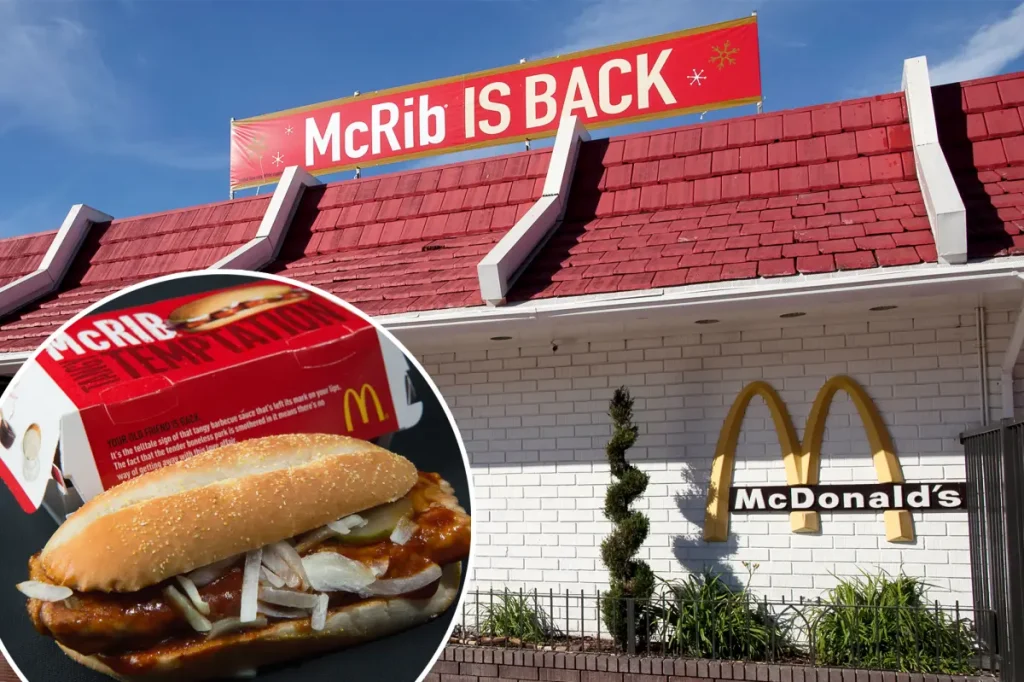The McRib Returns: Anatomy of a Fast-Food Phenomenon
In a move that has sparked both celebration and debate across social media, the legendary McRib sandwich has officially returned to McDonald’s restaurants nationwide. Making its latest comeback on Tuesday, the cult-favorite menu item continues its four-decade tradition of periodic appearances that generate remarkable levels of anticipation among fast-food enthusiasts. The tangy barbecue sandwich—featuring seasoned boneless pork slathered in sauce and topped with pickles and onions on a toasted bun—has developed a dedicated following since its original debut in 1981. Its return comes slightly earlier than its typical holiday season slot, with McDonald’s senior marketing director Guillaume Huin confirming availability at “most” U.S. locations and describing it as the brand’s “most-mentioned limited-time product online.” Participating cities include major metropolitan areas such as Miami, Dallas, Cleveland, St. Louis, Atlanta, Chicago, Seattle, and Los Angeles, giving fans across the country opportunities to satisfy their cravings for this divisive menu item.
The return of the McRib has triggered its customary social media frenzy, with enthusiasts tracking its availability through grassroots efforts like the McRib Locator website, which crowdsources sightings, prices, and receipt photos to confirm where the sandwich is being served. Prices appear to vary significantly by region, ranging from $4.99 in Oregon to nearly $7 in Seattle—a point of contention for some customers who have taken to Reddit to express frustration over the cost. Nevertheless, the excitement remains palpable among devoted fans, with one Redditor confessing they “almost cried out of happiness” upon securing a sandwich, while another noted they’re “always looking forward to the McRib time of year.” This passionate reception underscores the sandwich’s unique position in American fast-food culture, having transformed from a discontinued menu item into a cultural event that generates significant buzz whenever it makes its limited appearances.
The sandwich’s appeal, however, is far from universal. For every enthusiastic supporter, there seems to be an equally vocal detractor who dismisses it as “mystery meat at its finest” or describes it as merely “craveable” rather than genuinely good—comparing it to a TV dinner steak that satisfies a specific nostalgic hunger without qualifying as high-quality cuisine. Others lament that the current iteration doesn’t match their memories of McRibs past, suggesting changes in preparation or ingredients have diminished the experience. This polarized reception has become part of the McRib mythology, contributing to both its enduring appeal and the endless debates it inspires whenever McDonald’s announces its return. The divided reactions speak to how the sandwich has transcended its status as mere fast food to become something of a cultural touchstone that evokes strong opinions and nostalgic feelings among consumers.
The McRib’s curious history of disappearances and comebacks dates back to 1985, when it was initially pulled from menus due to underwhelming sales. Since then, its periodic returns—often marketed as “farewell tours”—have become an integral part of its mystique and marketing strategy. Food industry analysts have suggested that the sandwich’s availability is tied to fluctuations in pork shoulder prices, with McDonald’s typically bringing back the McRib during fall months when pork costs drop after the summer grilling season. This economic rationale adds another layer to the sandwich’s legend, suggesting that its limited availability is not merely a marketing tactic but also a strategic business decision based on supply chain economics. The unpredictability of its appearances has only served to heighten consumer anticipation, with fans eagerly awaiting announcements and speculating about when the next McRib season will begin.
Perhaps most remarkably, the McRib has developed significance that extends beyond the realm of fast food into unexpected territories like financial markets. In his announcement of the sandwich’s return, McDonald’s marketing director Huin acknowledged the curious correlation that some internet users have observed between McRib releases and financial market performance. Some cryptocurrency enthusiasts and market watchers have jokingly dubbed the sandwich an economic indicator, claiming that Bitcoin and the S&P 500 have historically rallied following McRib comebacks—particularly noting patterns in 2017, 2020, and 2021. Huin even pointed out that when the McRib returned to stores in December 2024, Bitcoin reached a new all-time high. While these connections are almost certainly coincidental, they illustrate how thoroughly the sandwich has penetrated popular culture, becoming a reference point that transcends its original purpose as a limited-time fast-food offering.
As with previous returns, McDonald’s has maintained an air of mystery about how long the McRib will remain available during this latest appearance. This strategic ambiguity is part of the sandwich’s appeal—the limited-time nature creates a sense of urgency among consumers who understand that the opportunity to enjoy a McRib could end without warning. This marketing approach has proven effective for decades, transforming what might otherwise be considered an ordinary fast-food sandwich into a special event that generates significant media coverage and consumer engagement. Whether loved for its unique flavor profile or derided as overhyped, the McRib phenomenon demonstrates the power of scarcity in marketing and the emotional connections that consumers form with familiar foods. For a certain segment of the population, the McRib represents more than just a meal—it’s a nostalgic experience and cultural moment that continues to resonate 40+ years after its introduction, securing its place in the pantheon of iconic American fast-food offerings.


